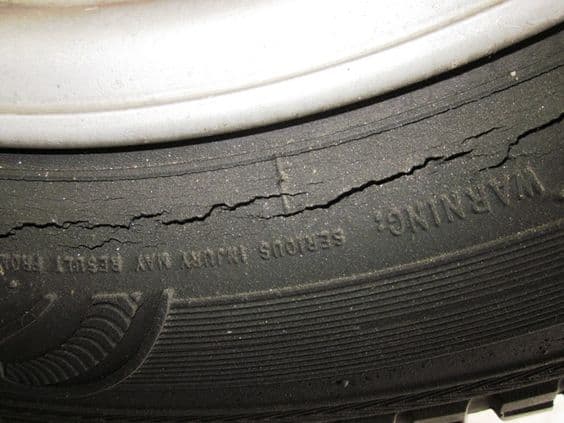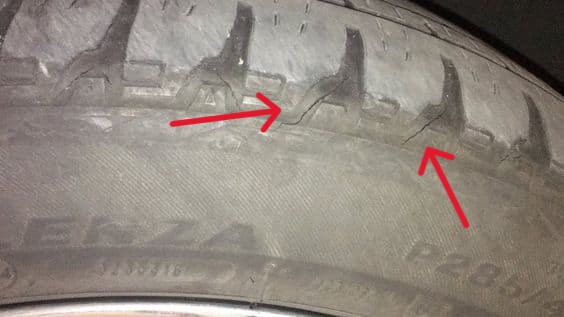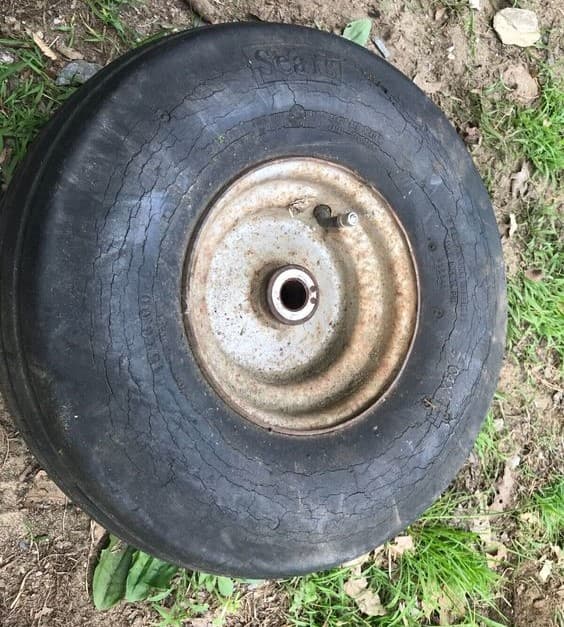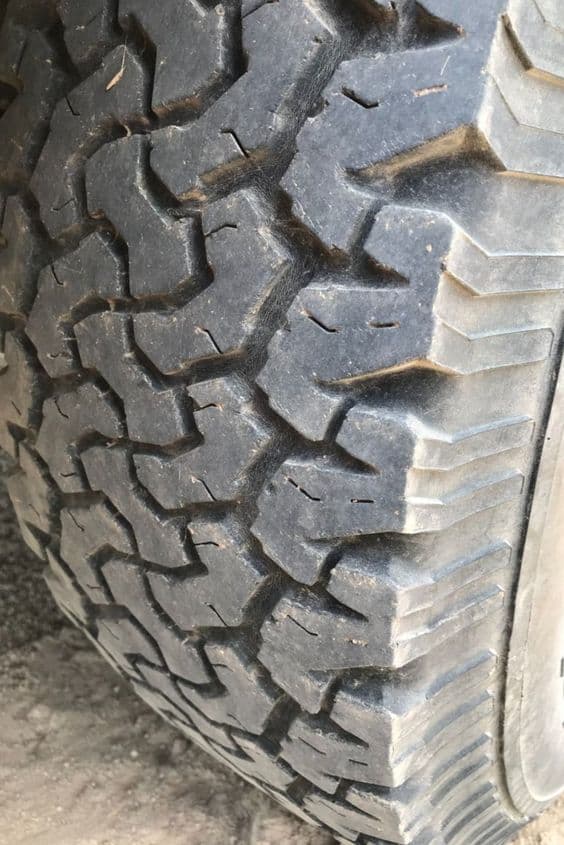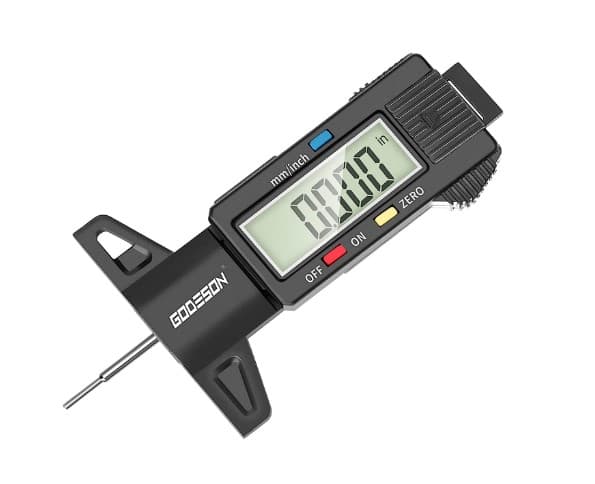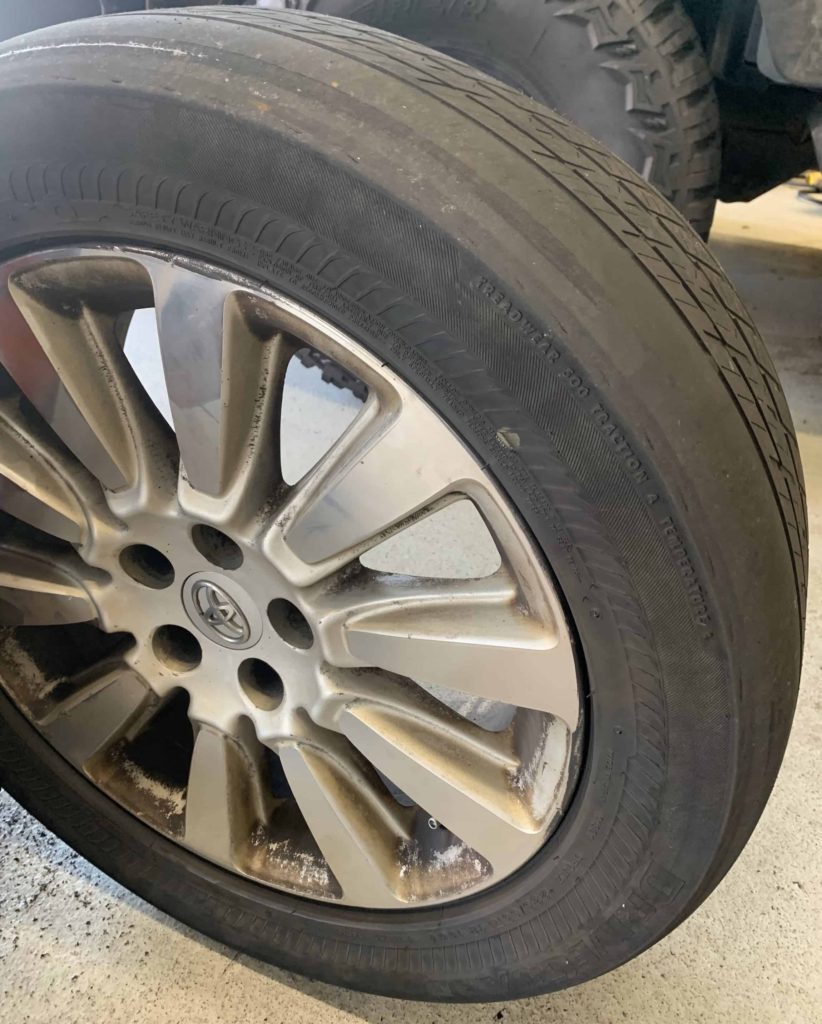Tire Dry Rot
The integrity and longevity of our tires are vital for safe and efficient transportation. Yet, there is a silent menace that lurks within the rubber compounds of our beloved tires: tire dry rot.
Tire dry rot, also known as sidewall cracking or weather checking, is a phenomenon that affects the structural integrity of tires over time. Understanding this insidious deterioration process is crucial for every vehicle owner, as it can have far-reaching implications on both safety and performance.
What is Tire Dry-Rot?
Tire dry rot refers to the degradation and deterioration of a tire’s rubber components due to various environmental factors such as exposure to sunlight, aging, and poor storage conditions. This process leads to the formation of small cracks on the surface of the tire’s sidewalls or tread area. These cracks can severely compromise the structural integrity of the tire, potentially resulting in catastrophic failure while driving.
Why Does Tire Dry Rot Matter?
Recognizing and comprehending tire dry rot is not merely an endeavor for automotive enthusiasts or industry professionals; it is a matter that concerns every driver. The consequences of neglecting this issue can be dire – from compromised traction and reduced handling capabilities to an increased risk of blowouts or accidents. By equipping ourselves with knowledge about this phenomenon, we empower ourselves to take proactive measures in preventing its occurrence and ensuring maximum safety on the road.
Therefore, in order to safeguard both our vehicles and our lives from potential harm caused by tire dry rot, it becomes imperative to delve deeper into understanding its causes, signs, preventive measures, impacts on performance and safety, as well as effective strategies for extending tire lifespan. By doing so we can equip ourselves with knowledge that will not only enhance our driving experience but also promote responsible vehicle maintenance practices.
Understanding tire Composition
Overview of Tire Structure and Components
Tires, often taken for granted, are marvels of engineering intricacy. They consist of several key components that work in harmony to provide traction, stability, and a comfortable ride. The outermost layer is the tread, which comes into direct contact with the road surface.
The tread pattern varies depending on the tire’s intended use, such as all-season or winter tires. Below the tread lies the sidewall which is responsible for protecting the tire’s internal layers from external forces.
Beneath these outer layers are multiple plies made of fabric cords (such as polyester or steel) that give structural strength to the tire. These plies are typically covered by an inner liner that acts as an air barrier to maintain proper inflation.
Role of Rubber in Tire Manufacturing
Central to a tire’s composition is rubber – nature’s versatile gift to mankind. In tire manufacturing rubber serves as both a binder and a cushioning material.
Natural rubber derived from latex sap harvested from trees or synthetic rubber produced from petroleum derivatives is blended with various chemicals and additives during the vulcanization process, where high heat and pressure transform it into a resilient solid compound. The presence of rubber provides elasticity and resilience to absorb shocks while maintaining shape integrity under strenuous conditions like cornering or heavy braking forces. Rubber enhances road grip through its ability to conform precisely to irregularities on various surfaces.
Causes of Tire Dry rot
Exposure to Sunlight and UV Radiation
One of the primary causes of tire dry rot is the relentless exposure to sunlight and the damaging ultraviolet (UV) radiation it carries. UV rays have a particularly detrimental effect on tires due to their ability to break down the molecular structure of rubber over time. When rubber is exposed to UV radiation it triggers a process called photo-oxidation, which leads to chemical changes within the rubber compound.
As a result the rubber becomes increasingly brittle and prone to cracking, ultimately leading to dry rot. Therefore, shielding tires (if possible) from direct sunlight is vital in preventing premature deterioration.
Importance of Protecting Tires From Direct Sunlight
Employing simple preventive measures such as parking in shaded areas or using protective coverings can significantly minimize sun-induced damage. Additionally, regular application of tire protectants containing UV inhibitors can act as a barrier against harmful rays and slow down the aging process caused by sunlight.
Age and Storage Conditions
Apart from sunlight exposure, age combined with inappropriate storage conditions represents another significant factor contributing to tire dry rot. Over time even when not in use, tires undergo a natural degradation process due to factors such as oxidation and evaporation of volatile components present in rubber compounds.
When tires age they become more susceptible to cracks and other forms of damage associated with dry rot. Improper storage conditions including extreme temperatures or high humidity levels can accelerate this deterioration process further by causing chemical reactions within the tire structure that lead to accelerated breakdown.
Impact of Time on Tire Degradation
The passage of time alone can gradually degrade the quality and performance of tires. The aging process occurs as a result of the continuous exposure to environmental elements and the ongoing chemical reactions within the rubber compounds.
As tires age the polymers in their composition slowly break down which causes them to lose elasticity and become more susceptible to dry rot. This natural degradation process is further exacerbated by external factors such as temperature fluctuations and humidity levels, which will both accelerate tire deterioration.
Influence of Temperature and Humidity on Tire Deterioration
Temperature variations and humidity levels have a profound impact on tire durability, particularly when it comes to dry rot. Extreme heat can accelerate the breakdown of rubber compounds, causing them to harden and develop cracks more rapidly.
Conversely, frequent exposure to low temperatures can lead to rubber becoming brittle over time. High levels of humidity increase moisture absorption by tires which promote chemical reactions that degrade their internal structure. It is crucial to store tires in controlled environments with stable temperatures and moderate humidity levels in order to mitigate these adverse effects.
Signs and Symptoms of tire Dry Rot
Cracking and Splitting on the Sidewall or Tread Area
Tire dry rot manifests primarily through cracking and splitting on the tire’s sidewall or tread area. These visible signs are indicative of the degradation of the rubber compounds within the tire. One type of crack commonly associated with dry rot is weather checking, which appears as fine, hairline cracks on the surface. These cracks are usually perpendicular to the direction of the tire’s tread and can extend across it.
Additionally, another type called ozone cracking may occur due to prolonged exposure to ozone in the atmosphere. Ozone cracks typically form parallel to the direction of the tread and can be deeper than weather-checking cracks.
Visual Indicators to Identify Dry Rot
Identifying dry rot visually requires careful examination of tires for specific indicators. Beyond cracking other visual signs include discoloration or fading of rubber material.
The affected areas may appear dull, brittle, or have a powdery texture when touched. If you notice small chunks or pieces of rubber flaking off from areas that show cracking or any other sign mentioned above, it is a clear indication that tire dry rot has occurred.
Loss of Flexibility and Increased Stiffness
Explanation Behind Loss in Elasticity
As tires age and experience dry rot, they undergo a loss in elasticity leading to reduced flexibility and increased stiffness. This loss occurs primarily due to chemical changes within the rubber compounds caused by oxidation processes over time. Oxidation weakens the molecular bonds in rubber molecules, resulting in decreased stretching capability and increased rigidity.
Impact on Tire Performance and Safety
The loss of flexibility associated with tire dry rot has direct implications for both performance and safety while driving. Firstly, reduced flexibility affects traction by decreasing grip levels between tires and road surfaces. Tires become less effective at gripping roads during acceleration, turning corners, or braking, leading to compromised vehicle control.
Secondly, stiffness caused by dry rot diminishes shock absorption capabilities, resulting in a harsher ride quality and increased vibration. Furthermore, the overall structural integrity of the tire is compromised, increasing the risk of sudden failure and potential blowouts while driving.
Understanding these signs and symptoms of tire dry rot is crucial for maintaining optimal vehicle performance and ensuring road safety. Regular inspections are necessary to identify any indications of dry rot early on and take appropriate measures to address them promptly.
Tire Maintenance to Prevent Dry Rot
Regular Cleaning and Inspection
To combat the potential onset of tire dry rot, regular cleaning and inspection are paramount. Cleaning tires not only enhances their appearance but also removes dirt, debris, and contaminants that can accelerate the degradation process. When cleaning your tires, use a mild detergent or specialized tire cleaner along with a soft-bristle brush to gently scrub the rubber surface.
Avoid using harsh chemicals or abrasive cleaners that can damage the rubber compound. After cleaning make sure to rinse thoroughly and allow the tires to dry completely before moving on to the inspection stage.
Proper Cleaning Techniques for Tires
When it comes to cleaning tires effectively, there are a few important techniques to keep in mind. Firstly, always clean one tire at a time to ensure thoroughness and prevent cleaning agents from drying out on other surfaces. Begin by wetting the tire with water before applying the cleaner or detergent.
Use a brush with soft bristles or a sponge specifically designed for automotive detailing purposes. Scrub gently in circular motions, paying extra attention to sidewalls where dry rot often manifests itself first.
Importance of Regular Inspections
In addition to regular cleanings, frequent inspections play an integral role in preventing tire dry rot. Developing a habit of inspecting your tires visually can help identify early signs of degradation such as cracking or splitting.
Pay close attention not only to the tread area but also examine all sidewalls thoroughly as they are particularly susceptible to dry rot due to exposure from UV rays and environmental elements like ozone. By conducting visual inspections regularly, you increase your chances of catching any developing problems early on which allows for prompt action.
Proper Storage Practices
Proper storage is crucial when it comes to preventing tire dry rot during periods of non-use or long-term storage such as seasonal changes or multiple tire sets. To ensure optimal longevity, follow these tips for storing your tires:
Start by cleaning the tires thoroughly to remove any dirt or debris that might have accumulated. W
Wrap each tire in an airtight plastic bag to prevent exposure to moisture and humidity.
Store the tires in a cool, dry place away from direct sunlight and extreme temperature fluctuations.
Avoid contact with oils, solvents, and other chemicals that can deteriorate rubber compounds over time.
Tips for Storing Tires Long-Term
When it comes to long-term storage of tires, there are certain steps you can take to further protect them from dry rot.
Consider using tire racks or stands to keep the weight of stacked tires evenly distributed, preventing deformation and stress on specific areas.
If space permits, hanging the tires individually on hooks is also a viable storage method as it eliminates any potential pressure points while allowing air circulation.
Periodically rotate stored tires every three months to prevent flat-spotting caused by prolonged immobility in the same position.
Ideal Storage Conditions to Prevent Dry Rot
To ensure optimal storage conditions that mitigate the risk of tire dry rot development during periods of non-use, adhere to these guidelines. Aim for an environment with low humidity levels as excess moisture can accelerate degradation processes. Ideally, maintain a relative humidity level below 50%.
Additionally, store your tires in a location where temperatures remain consistent and do not exceed 85°F (29°C). Fluctuating temperatures contribute to rubber expansion and contraction cycles that subject the material to undue stress over time.
By implementing these tire maintenance practices such as regular cleaning and inspections along with proper storage techniques under ideal conditions, you significantly reduce the chances of experiencing premature tire dry rot issues.
Impact on tire Performance & Safety
Reduced Traction & Handling Capabilities
When tire dry rot occurs it significantly diminishes the tire’s ability to maintain optimal traction on the road surface. The cracks and splits that develop weaken the rubber’s grip, causing a loss of friction between the tire and the road.
This compromised grip hampers the tire’s ability to effectively respond to steering inputs, resulting in reduced handling capabilities. As a driver navigates curves or maneuvers in hazardous conditions, such as rain or snow, tires affected by dry rot are more likely to slip and slide, compromising overall safety.
Influence on Braking Distance
One undeniable consequence of tire dry rot is its negative impact on braking performance. The cracks present on rotted tires create irregularities in the contact patch between the tire and the road. As a result when brakes are applied these irregularities can interfere with uniform pressure distribution across the entire tread area.
This leads to decreased braking efficiency and an extended braking distance. In emergency situations where split-second decisions make all the difference, rotted tires can dangerously prolong stopping times and compromise overall safety.
Effects on Vehicle Stability
Tire dry rot also poses a significant threat to vehicle stability. As cracks deepen and multiply over time due to neglect or prolonged exposure to adverse conditions, they weaken the structural integrity of tires.
This compromises their ability to withstand lateral forces during turns or sudden lane changes. Rotted tires are more prone to sidewall failure under stress, jeopardizing vehicle stability and increasing the risk of rollovers or loss of control in critical driving situations.
Potential for Blowouts & Accidents
Risks Associated With Driving on Rotted Tires
The potential for blowouts is one of the gravest dangers associated with driving on rotted tires. As the rubber degrades it becomes more brittle and less able to withstand the internal pressure generated by the weight of the vehicle.
This can lead to sudden tire failures, resulting in a loss of control that may cause accidents, especially at high speeds or when cornering. If a blowout occurs while driving on a highway or other busy roads the sudden loss of control can result in collisions with other vehicles or objects, posing serious risks to both the driver and others on the road.
Preventative Measures to Ensure Safety
To ensure road safety and prevent accidents caused by dry-rotted tires, regular inspection and maintenance are paramount. Drivers should frequently examine their tires for signs of dry rot such as cracks, splits, or loss of flexibility. If any indications are present, immediate action should be taken to replace the affected tires.
Extending Tire Lifespan
Proper Inflation Pressure
Maintaining the correct tire pressure is vital not only for performance but also for preventing dry rot. Underinflated tires tend to flex more while driving which causes increased heat buildup and accelerated rubber aging.
On the other hand, overinflated tires put excess stress on the rubber making it prone to cracking and ultimately leading to dry rot. Regularly checking tire pressure using a reliable gauge and inflating them according to manufacturer specifications can significantly prolong their lifespan. This means when your tire pressure light comes on your dashboard, fix the pressures ASAP!
Avoidance of Harsh Chemicals
Using harsh chemicals such as petroleum-based cleaning agents or silicone-based dressings on your tires can have detrimental effects on their longevity. These substances tend to strip away the protective compounds within the rubber formulation, leaving them vulnerable to premature aging and dry rot. Instead, opt for gentle cleaners specifically designed for automotive use that do not contain aggressive solvents or damaging ingredients.
Keep in Mind
Understanding tire dry rot is essential for every vehicle owner who seeks optimal performance and safety on the road. By comprehending its causes you can take proactive steps towards preventing this phenomenon from occurring. Remember, a little care goes a long way in preserving the integrity of your tires and enhancing your overall driving enjoyment!
